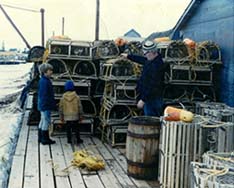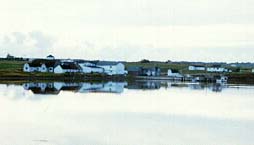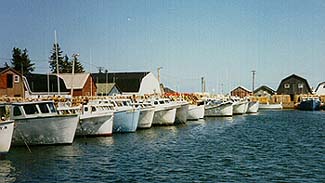









Lobster has slowly but surely become the mainstay of the Island's fishing industry. The bluish-green crustacean-- which only turns its trademark red after boiling-- has become as recognizable a symbol of P.E.I. as the potato, and the Island is world famous for the succulent meals offered at its lobster suppers. The lobster has not always been the gourmet dish it is now. Many seniors can recall the days when lobster bodies were spread on the fields, and only poor children brought lobster sandwiches to school. Nevertheless, the lobster fishery has been a major economic player on the Island for over a hundred years. While the number of traps in the water has fallen-- down from 280,000 at the turn of the century to 130,000 in 1997-- lobster fishery still represents an important source of jobs and income on Island, with close to 450 fishermen heading out for the 1997 season.
 The
life of a lobster fisherman was one of exhausting work
and severe risks. Traditionally, fishermen hauled in
their catch from small sailboats, which had to be
launched into the sea each morning and hauled out of the
water at night. Their hands were worn raw from hauling
their lines by hand, pulling the traps full of lobster up
from the sea bottom. Fishermen were out on the water from
daybreak to sunset. The sea shanties and shacks they
built along the wharves not only housed their supplies,
but also became like a second home, providing shelter in
between trips out to sea and during bad weather.
The
life of a lobster fisherman was one of exhausting work
and severe risks. Traditionally, fishermen hauled in
their catch from small sailboats, which had to be
launched into the sea each morning and hauled out of the
water at night. Their hands were worn raw from hauling
their lines by hand, pulling the traps full of lobster up
from the sea bottom. Fishermen were out on the water from
daybreak to sunset. The sea shanties and shacks they
built along the wharves not only housed their supplies,
but also became like a second home, providing shelter in
between trips out to sea and during bad weather.
Besides this daily grind, the life of a fishermen also meant accepting grave dangers, as the small boats could be tossed about like a cork in heavy seas. The same waters which gave them their livelihood could just as easily take their lives. Everett Burns of Seaview-- a fishing community located 20 km from Kensington-- drowned while setting his lobster traps at the beginning of the 1935 fishing season. During the very same year, there was a near drowning in Seaview. Herbert Coulson and his brother Leslie had just hauled in a lobster catch when, without any warning, a huge swell rolled towards them and capsized their boat in two fathoms of water. They managed to cling to the keel until, miraculously, another wave flipped the boat back over and they were able to climb back inside. At first, they were moored and could not move out of the rough seas. But once again, the waves that had nearly drowned them now came to their rescue, as the impact from a swell freed their anchor and allowed the craft to drift back to shore.
Once they stumbled up onto the shore, the Coulsons were treated by their cousin, a nurse who tried to work the water from their lungs, and taken to the home of John Coulson, where they were wrapped in blankets and given hot toddies to ward off hypothermia. But by the very next morning, the young men were out fishing again. The sea could be just as forgiving as it was fierce, and being a lobster fisherman involved taking a certain leap of faith.
 The local fish
factories had a man that would come to each wharf, haul
lobsters from the boats, provide fishermen with bait, and
travel to Kensington and Malpeque to pick up supplies.
Beginning in the 1860s, these fish plants started to
become part of a burdgeoning lobster processing industry.
In 1870, there was about 6,700 pounds of lobster being
canned on P.E.I. But the industry expanded quickly and,
by 1882, 4.8 million pounds were being exported. The year
1901 saw a total of two hundred and twenty-seven lobster
factories up and running on P.E.I., churning out canned
lobster for the export market. Just in the Kensington
region alone, there were canneries in Malpeque, Darnley,
Seaview, and French River (map), just to mention a few.
The local fish
factories had a man that would come to each wharf, haul
lobsters from the boats, provide fishermen with bait, and
travel to Kensington and Malpeque to pick up supplies.
Beginning in the 1860s, these fish plants started to
become part of a burdgeoning lobster processing industry.
In 1870, there was about 6,700 pounds of lobster being
canned on P.E.I. But the industry expanded quickly and,
by 1882, 4.8 million pounds were being exported. The year
1901 saw a total of two hundred and twenty-seven lobster
factories up and running on P.E.I., churning out canned
lobster for the export market. Just in the Kensington
region alone, there were canneries in Malpeque, Darnley,
Seaview, and French River (map), just to mention a few.
Unfortunately, the expansion of the lobster industry led to overfishing. At one point, when the stocks were healthy, it seemed as if there was no limit to how many lobsters could be pulled out of the water. There were few fishery officers and anyone wanting to fish did so. There were no lower limits on size, and many lobsters were caught before they had a chance to breed. Catches were purchased according to the number of lobster, not by the pound as they are today. But the shrinking of stocks has led to ever-tighter management of the resource. Any violations of fishery regulations are accompanied by hefty fines or even the loss of licenses. Every lobster is measured carefully to make certain it exceeds the minimum size requirements.
Fishermen today are receiving four to five
dollars a pound, whereas their grandfathers were
receiving four to five cents. While fishers in the past
cut the breakers in small sailing vessels, they now
captain modern fiberglass  boats,
fully equipped with sonar and depth-finding equipment.
The season is a short one-- lasting only between May 1
and June 30-- and they have to be strategic in where they
place their traps. While these changes to prices and
techniques also have to do with changing times, they also
reflect another sad fact about the East coast fishery.
There are fewer lobsters on the bottom, and they are
getting harder to find.
boats,
fully equipped with sonar and depth-finding equipment.
The season is a short one-- lasting only between May 1
and June 30-- and they have to be strategic in where they
place their traps. While these changes to prices and
techniques also have to do with changing times, they also
reflect another sad fact about the East coast fishery.
There are fewer lobsters on the bottom, and they are
getting harder to find.